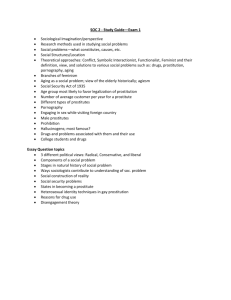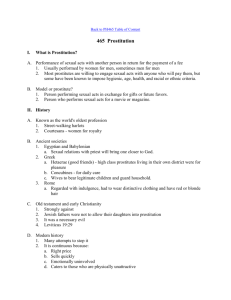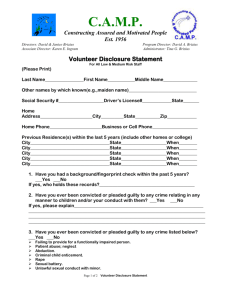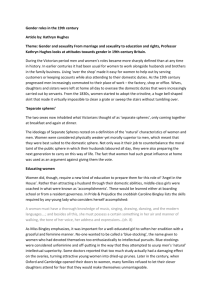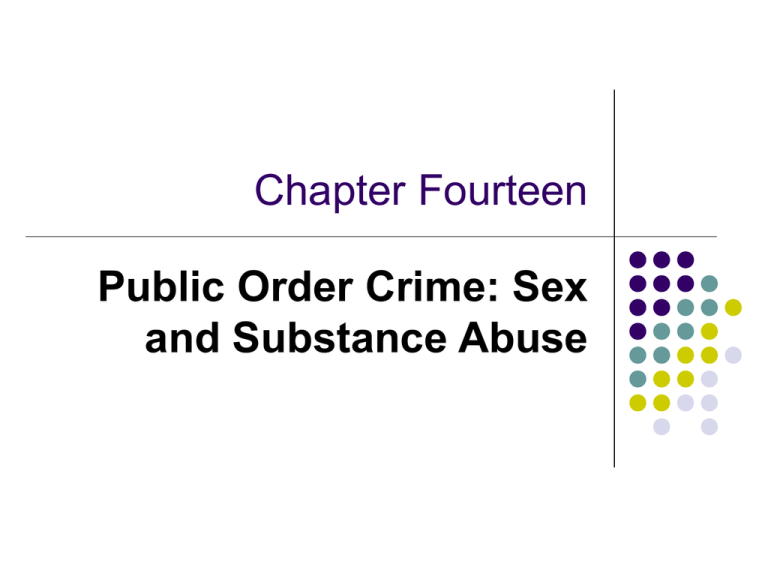
Chapter Fourteen
Public Order Crime: Sex
and Substance Abuse
Public Order or Victimless Crimes
Acts that are not in conformity with social
norms, customs and values.
Laws to ensure public order usually prohibit
the manufacture and distribution of morally
questionable goods and services, i.e., exotic
material, commercial sex and mood-altering
drugs.
Law and Morality
Are victimless crimes really victimless?
Some believe that pornography, prostitution
and drug use erode the morals of society and
should be prohibited and punished.
Others believe that morality cannot be
legislated and persons should be free to
choose their own moral standards.
Social Harm
Many acts deemed highly immoral and
objectionable are not in fact criminal.
Immoral acts are different from crimes on the
basis of the social harm they cause.
Moral Crusades/Moral Crusaders
Vigilantes of the old West had strict
standards of morality and when they caught
the perpetrator, justice was sure and swift;
this remains part of popular culture.
Moral Crusaders may engage in immoral and
illegal acts in an attempt to protect society.
Moral Crusades/Moral Crusaders
One area of controversy is the gay lifestyle.
In Lawrence v Texas the court held that
states could not criminalize oral or anal sex.
All sodomy laws are now unconstitutional and
unenforceable; acts that were a crime are
now legal.
Sexually Related Offenses
Paraphilias—bizarre or abnormal sexual
practices involving recurrent sexual urges
focused on:
Nonhuman objects
Humiliation or experience of receiving or giving
pain
Children or others who cannot grant consent
Sexually Related Offenses
Outlawed sexual behaviors include:
Asphyxiophila—attempting partial asphyxia and
oxygen deprivation to the brain to enhance sexual
gratification.
Frotteurism—rubbing against or touching a
nonconsenting person in a crowded or public
area.
Voyeurism—obtaining sexual pleasure from
spying on a stranger while he or she disrobes or
engages in sexual behavior with another.
Sexually Related Offenses
Exhibitionism—deriving sexual pleasure from
exposing the genitals to surprise or shock a
stranger.
Sadomasochism—deriving pleasure from
receiving pain or inflicting pain on another.
Pedophilia—attaining sexual pleasure
through sexual activity with prepubescent
children.
Sexually Related Offenses
Paraphilias involving unwilling or underage
victims are illegal.
Most states outlaw indecent exposure and
voyeurism.
Prostitution
Defined as granting non-marital sexual access,
established by mutual agreement of the prostitutes ,
their clients and their employers, for remuneration.
Prostitution has been around for thousands of years.
Conditions usually present in a commercial sexual
transaction:
Activity that has sexual significance for the customer,
economic indifference and emotional indifference.
International Sex Trade/
Sex Tourism
The international sex trade: some countries
have legalized prostitution; in others,
prostitution can carry the penalty of death.
Sex tourism—wealthy men visit semiregulated sex areas in needy nations in order
to procure young girls forced or sold into
prostitution.
International Sex Trade/
Sex Tourism
There is a huge demand for pornography,
strip clubs, lap dancing, escorts and
telephone sex in developing countries.
In addition, hundreds of thousands of women
and children, most from Southeast Asia and
eastern Europe, are lured by the promise of
good jobs and then are forced into brothels or
as circuit travelers in labor camps.
International Sex Trade/
Sex Tourism
Traffickers annually import approximately
50,000 women and children every year into
the U.S. despite legal prohibition.
Types of Prostitutes
Streetwalkers—prostitutes who work the
streets in plain sight of police, citizens and
customers are referred to as hustlers,
hookers or streetwalkers.
These women wear bright clothing, makeup
and jewelry to attract customers and usually
take customers to hotels.
“Working the streets” is extremely dangerous
for this woman.
Types of Prostitutes
Brothel prostitutes—flourished in the 19th and
early 20th centuries.
Also known as bordellos, cathouses, sporting
houses and houses of ill repute.
A madam is usually in charge of the “house”.
This is a woman who employs prostitutes,
supervises their behavior and receives a fee
for her services; her cut is usually 40 to 60
percent of the prostitute’s earnings.
Types of Prostitutes
Call girls—aristocrats of prostitution, most
come from middle-class backgrounds and
service upper-class customers.
Call girls either entertain clients in their own
apartments or visit clients’ hotels and
arguments.
Escort services—usually fronts for
prostitution rings.
Types of Prostitutes
Call houses combine elements of the brothel
and call girl rings; the madam receives a
phone call and sends a prostitute to the
caller.
Circuit travelers—prostitutes move around in
groups of two or three to lumber, labor and
agricultural camps.
International Trafficking in
Prostitution
Trafficking for sexual exploitation is a global
concern.
This can be through force, coercion,
manipulation, deception, abuse of authority,
initial consent, family pressure, past and
present family and community violence,
economic deprivation or other conditions.
International Trafficking in
Prostitution
Most traffickers are men and many are
involved in organized crime syndicates.
Between an estimated 600,000 to 1.2 million
men, women and children are trafficked
annually.
Human trafficking depends on social
problems and disorder a well as economic
crises.
International Trafficking in
Prostitution
Skeezers—women who trade sex for drugs.
Usually crack users, homeless and
unemployed and suffer psychological
distress.
Massage parlors/photo studios—some
prostitutes are based in these locations.
Becoming a Prostitute
Most come from troubled homes; many
experience sexual trauma at a young age.
They have limited education and frequently
use drugs.
HIV and STDs are constant worries, as are
danger and violence.
Controlling Prostitution
Prostitution is a misdemeanor, punishable by
fine or short jail sentence.
Most states punish both people engaging in
prostitution.
Most law enforcement aims at confining
these activities to particular areas in a
jurisdiction.
Legalize Prostitution?
Mixed feelings—sexual equality and free
choice.
Advocates both for and against prostitution
should be decriminalized, but not legalized.
Pornography/Obscenity
Pornography—this material is to provide
sexual titillation and excitement for paying
customers.
Obscenity—this material is “deeply offensive
to morality or decency…designed to incite
lust or depravity”.
While adult materials are widely accepted,
the courts have held that the First
Amendment was not for protecting indecency.
Pornography/Obscenity
Child pornography—sexual exploitation can
devastate victims, causing physical and
psychological problems.
Some studies have found a link between
pornography and violence.
Nonaggressive men do not become sexual
predators if exposed to pornography; those
with a predisposition to violence may.
Pornography/Obscenity
While not impossible, it is difficult to
prosecute due to the First Amendment
protection of free speech/free expression.
Control of pornography is also difficult; one
approach has been to restrict the sale to
certain boundaries.
Substance Abuse
Urban areas are full of drug dealing gangs,
drug users who commit crime to support their
habits and alcohol-related violence.
Rural areas are staging centers for both
manufacture and shipment of drugs.
Great debate over legalization of drugs and
control of alcohol.
Substance Abuse
Drug use has gone on for years; opium-related
drugs were easily obtained.
Alcohol was prohibited in the U.S. by the Volstead
Act (1919) as a result of the temperance movement.
Prohibition was a failure—organized crime supplied
illegal liquor; bootleggers corrupted law
enforcement.
The 21st Amendment repealed Prohibition in 1933.
Extent of Drug Abuse
The U.N. monitors drug cultivation and use
globally in an annual survey.
Monitoring the Future (MTF) surveys of U.S.
adolescents who use illegal drugs or drink
alcohol has declined in the past decade.
MDMA (ecstasy) is the only drug with
increased use.
Extent of Drug Abuse
National Survey on Drug Use and Health,
while indicating a slight decline in use of
illegal substances, 20 million Americans aged
12 or older had used an illegal drug in the
past year.
Extent of Drug Abuse
Alcohol abuse is a pattern of drinking, in 12
months time that results in one or more of the
following:
Failing to fulfill major work, school or home
responsibilities;
Drinking in situations physically dangerous;
Having recurring alcohol-related legal problems;
Continuing drinking while having ongoing
relationship problems caused by drinking.
Extent of Drug Abuse
Alcohol dependence (alcoholism) includes:
Craving
Loss of control
Physical dependence
Tolerance
Extent of Drug Abuse
Intravenous (IV) drug use is tied to the threat
of AIDS, largely due to the habit of needle
sharing among IV users.
Causes of Substance Abuse
Subcultural view—large number of drug
abusers are poor with low self-esteem, often
subjected to racial prejudice.
Psychological view—drug use linked to
psychological deficits such as personality
disturbance and emotional problems,
regardless of economic class.
Causes of Substance Abuse
Genetic factors—substance abuse may have
genetic basis in parents behavior
Social learning—drug abuse results from
observing parental (or other) drug use.
Problem Behavior Syndrome (PBS)—drug
abusers are maladjusted, alienated and
emotionally distressed and drug use is only
one of many social problems.
Causes of Substance Abuse
Rational choice—choose to use due to
enjoying drug’s effects, both physical and
emotional.
Mixed opinions on whether a drug gateway
(from alcohol to marijuana to more serious
drugs) is real.
Types of Drug Users
Adolescents who distribute small amounts of
drugs.
Adolescents who frequently sell drugs.
Teenage drug dealers who commit other
delinquent acts.
Adolescents who cycle in and out of the
justice system.
Drug-involved youth who continue to commit
crimes as adults.
Types of Drug Users
Outwardly respectable adults who are toplevel dealers.
Smugglers
Adult predatory drug users who are
frequently arrested.
Adult predatory drug users who are rarely
arrested.
Less predatory drug-involved adult offenders.
Types of Drug Users
Outwardly respectable adults who are
frequent users.
Women who are drug-involved offenders.
Drugs and Crime
Many substances are criminalized due to the
association between drug abuse and crime
In self-report user survey reports, people who
take drugs have extensive involvement in
crime.
Arrestee data estimates that 1.2 million adults
aged 18 and older were arrested for a serious
violent or property offense in the past year.
Drugs and Crime
Prison inmate surveys indicate that many
prison inmates are lifelong substance
abusers.
Many criminals are substance abusers.
Drugs and the Law
Various federal laws have attempted to
increase penalties imposed on drug
smugglers and limit the manufacture and sale
of newly developed substances.
Drug control strategies include stopping the
flow of drugs into the country, apprehending
and punishing dealers and cracking down on
street-level drug deals.
Drugs and the Law
War and terrorism has made control of drug
sources difficult.
Interdiction strategies have not been as
successful as hoped due to the vast
unprotected U.S. borders.
Law enforcement strategies are usually
directed at drug rings or the intimidation of
street drug dealers.
Drugs and the Law
Punishment strategies—prosecution and
punishment of drug offenders is a top priority,
but this has not been very successful.
Many people believe that drug offender
punishment is too severe.
Community Strategies/Citizensponsored Programs
Categories of programs to combat drugs:
Law enforcement-type efforts.
Use the civil justice system to harass offenders.
Community-based treatment efforts
Enhance the quality of life, improve interpersonal
relationships and upgrade the neighborhood’s
physical environment.
However, little evidence that these are effective
on drug control.
Community Strategies/Citizensponsored Programs
Education strategies—DARE (Drug Abuse
Resistance Education) is designed for
elementary school students.
Drug testing in schools and the workplace is
often suggested to deter substance abuse.
Drug Courts
These courts handle cases involving drugaddicted offenders through extensive
supervision and treatment programs.
The courts also address the overlap between
the public health threats of drug abuse and
crime.
National evaluations suggest that some drug
courts are more effective than others.
Drug Courts
Employment programs, involving skills
training, aid in reducing the incidence of
substance abuse.
Legalization of drugs might aid as the price
and distribution of drugs could be controlled
by the government.
Some claim that legalization might reduce the
association between drug use and crime in
the short-term but might result in grave social
consequences.
Drug Courts
The problems of alcoholism may be a
warning of what can happen when controlled
substances are made readily available.

